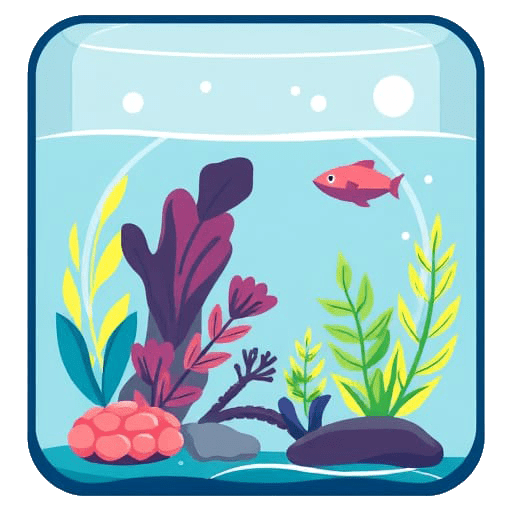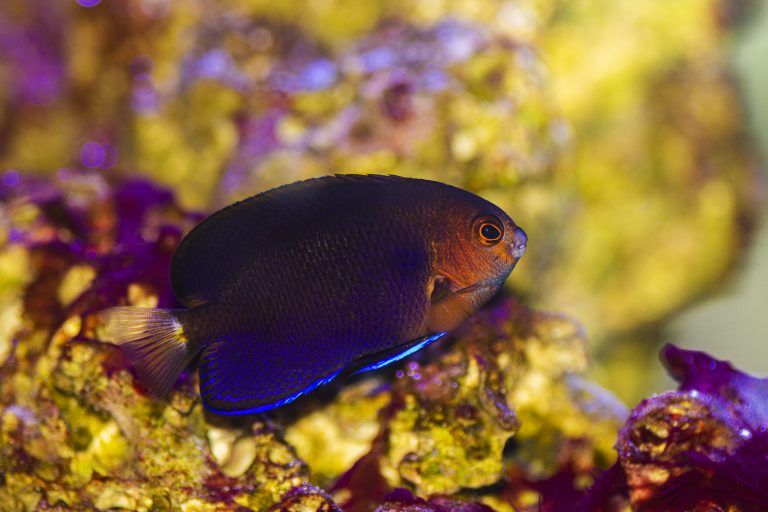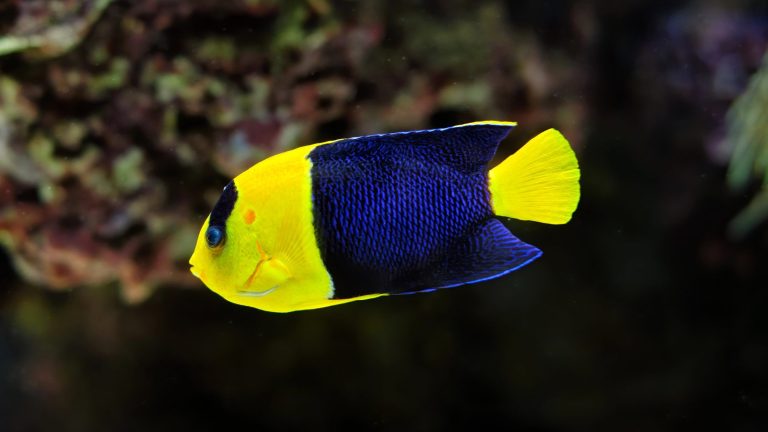The Tailspot Blenny (Ecsenius stigmatura) is a very small but incredibly personable species of Blenny. This species is predominantly brown/orange, with an eye-catching black dot just before their tail. Tailspot Blennies only grow to about 2.5 inches. Their size and peaceful personality make them excellent options for nano fish tanks. Although they are not powerhouses for algae removal, they still do some work at keeping algae at bay. This article will go into the general care of Tailspot Blennies, including information on aquarium requirements, dietary needs, compatible tank mates, and more.
Aquarium Requirements
Tailspot Blennies are small fish that are an excellent option for nano saltwater fish tanks. As stated earlier, they only grow to 2.5 inches, so they’ll do great in aquariums that are 10 gallons or larger. This species finds a hole in a piece of live rock to call home. It will spend time grazing on algae growing on rockwork, and you’ll often find it perched on rocks, equipment, or other decor. I encourage providing many different pieces of live rock for your Tailspot Blenny.
Blennies can jump out of aquariums. I highly suggest providing a lid for your fish tank to help prevent that.
Are Tailspot Blennies Reef Safe?
Yes, Tailspot Blennies are generally reef-safe. There are always exceptions to the rule. I have read and heard of stories of some Tailspot Blennies nipping or attacking coral. Those stories are incredibly scarce, but they can happen. Tailspot Blennies are usually quite passive and do not bother coral, especially if they are provided with plenty of rockwork and places to graze. Fish are opportunists, if they find an easy source of food, they may just take the opportunity to use that resource.
Water Parameters
Ideally, the aquarium’s temperature should be maintained between 72°F and 78°F (22.2°C to 25.5°C). The salinity should be around 1.020 to 1.025 specific gravity. In terms of pH, a range of 8.1 to 8.4 is optimal. This reflects the alkaline conditions typically found in a marine habitat. For Tailspot Blennies, alkalinity measured in dKH should be maintained between 8 and 12 dKH. Many of these water parameters can be achieved through water changes, and proper temperature ranges can be reached using aquarium heaters.
There are many tools to monitor salinity levels. You can learn about them by checking Different Salinity Reading Tools For Saltwater Fish Tank. Many heaters are available in this hobby. Take a look at many great options by looking at 6 Best Aquarium Heaters for Freshwater & Saltwater Fish Tanks.
Food & Diet
Tailspot Blennies are herbivores. They will spend quite a bit of time nipping and grazing on algae growing on rockwork and other hard surfaces. The amount of algae growing in an aquarium may not be enough to sustain a Tailspot Blenny, depending on the size of the aquarium. It’s important to have supplemental food ready for your fish in case you see them going hungry. Tailspot Blennies should take different foods without issue. If you’re looking for fish food focused on herbivores, consider looking at 12 Best Fish Food for Herbivores – Salwater Edition.
Tank Mates
Many peaceful saltwater fish will be excellent tank mate options for Tailspot Blennies. This fish is small, so it can be easily bullied and outcompeted for food. You’ll have to keep that in consideration when picking tank mates. Tailspot Blennies should do well with Cardinalfish, Clownfish, Dwarf Angels, Gobies, and Peaceful Wrasses, which are some of the common fish that should not have an issue with Tailspot Blennies.
Although I do not advise it, it may be possible to keep multiple blenny species in the same aquarium. I only mention this for fishkeepers with quite a bit of experience and for aquariums that are 125 gallons or larger. It’s always a gamble adding a fish with a similar body shape and coloration as another. With plenty of live rock and space, it may just work out.
Breeding
I do not have breeding information for Tailspot Blennies.
Final Notes
Bicolor Blennies are fantastic additions to an aquarium. I have kept many in reef tanks without issue and they rarely bother other fish in the aquarium. They’re great at picking on algae on live rock and have fantastic personalities when they explore their surroundings. I highly recommend checking out the Bicolor Blenny if your fish tank can fit one.
Thanks for clicking this tab, this is planned for a future feature of this website!




